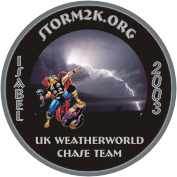Hope you can help!
For a long time now I have always thought that formation of a tornado can be attributed to the updraft rising within a confined space, rather like water going down a plug hole that generates rotation and the vortex. I have a problem with a horizontal vortex being moved to vertical because of the updraft. Indeed, here in Jersey we have had many waterspouts and funnels this year and each time the cumulus seems to grow at rapid rates just after the funnel fueling my theory.
What do you think?
TORNADO FORMATION
Moderator: S2k Moderators
- ChaserUK
- Category 2

- Posts: 630
- Joined: Thu Aug 28, 2003 4:10 pm
- Location: Jersey, Channel Islands
- Contact:
TORNADO FORMATION
0 likes
-
LakeErieWX
- Tropical Wave

- Posts: 1
- Joined: Sat Jan 27, 2007 8:09 am
- Location: Cleveland, Ohio
Re: TORNADO FORMATION
Can you clarify your question? What and where is the "confined space" within the storm?
0 likes
- Wthrman13
- Professional-Met

- Posts: 502
- Joined: Sun Jul 06, 2003 12:44 pm
- Location: West Lafayette, IN
- Contact:
Re: TORNADO FORMATION
ChaserUK wrote:Hope you can help!
For a long time now I have always thought that formation of a tornado can be attributed to the updraft rising within a confined space, rather like water going down a plug hole that generates rotation and the vortex. I have a problem with a horizontal vortex being moved to vertical because of the updraft. Indeed, here in Jersey we have had many waterspouts and funnels this year and each time the cumulus seems to grow at rapid rates just after the funnel fueling my theory.
What do you think?
Waterspouts probably do grow more from the mechanism you are referring to, which is simply vorticity stretching. When you see a whirlpool in a drain, this is what is happening. The vorticity already present in the water (due to random motions and the shape of the basin) is stretched by the downward acceleration of the water into the drain, producing a concentrated vortex. The same thing can happen with tornadoes, both as a formative mechanism, and as one that intensifies an already-present tornado. For example, waterspouts tend to form along horizontal wind-shear boundaries, and the updraft of the cumulus cloud as it is developing stretches this initially weak rotation into a concentrated, intense vortex.
However, tilting of horizontal vorticity into the vertical is still thought to be very important, and possibly the dominant process by which many tornadoes are initially formed (particularly those that develop out of mesocyclones in supercell storms). It has long been accepted that mid-level mesocyclones do indeed form from this mechanism, but this is on a much larger scale (mesocyclones are typically on the order of several kilometers in diameter) and doesn't necessarily explain the development of the much smaller-scale tornado vortex. This is an active area of research, and we still don't have a firm grasp on the most important routes to tornadogenesis. The point I'm trying to make is that both processes (tilting of horizontal vorticity, and stretching of pre-existing vertical vorticity) are probably important at least at some point in most tornadoes' life cycles.
0 likes
Return to “Got a question? I'm listening”
Who is online
Users browsing this forum: No registered users and 256 guests
